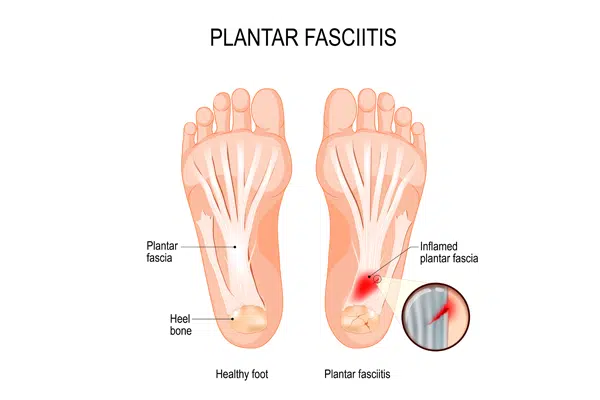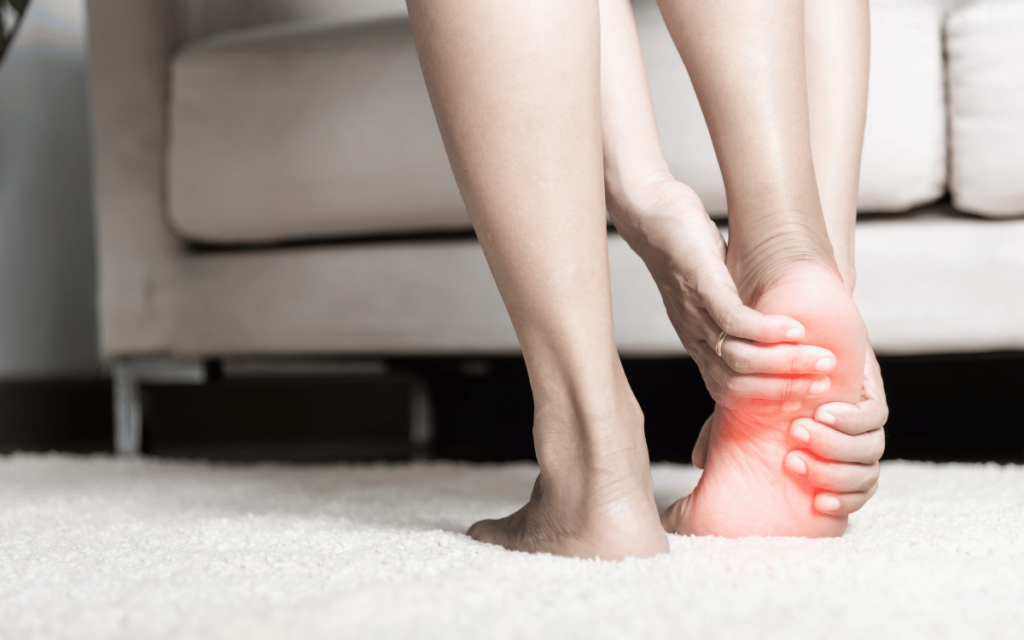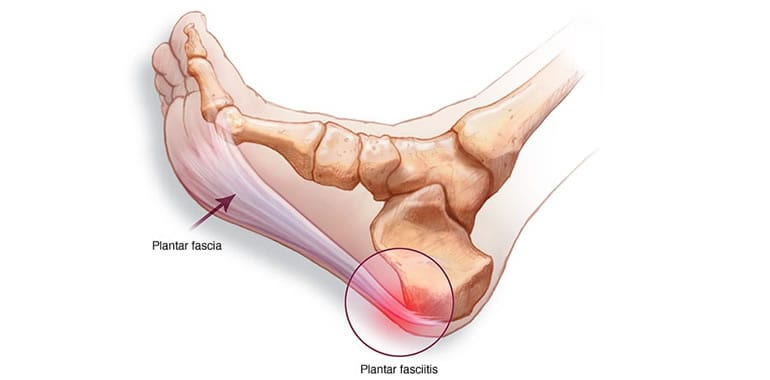Plantar Fasciitis Treatment in Perth
Do you suffer from a sharp, stabbing pain in the heel or bottom of the foot?
Or a pain that worsens as you stand, climb, tiptoe, etc?
A pain that is worse after long periods of rest or first thing in the morning?
Please read on for how we can help you.
What is Plantar Fasciitis?

Plantar Fasciitis (fasciopathy) is one of the most common cause of plantar heel pain. It presents in both sedentary and athletic populations.
Risk factors for plantar fasciitis include:
- prolonged periods of weightbearing (standing, walking or running)
- obesity or increase weight gain
- biomechanical factors such as flat feet, leg length discrepancy, injuries etc.
What are the Symptoms of Plantar Fasciitis?
Some of the most common symptoms for plantar fasciitis include pain in the morning when getting out of bed or after periods of rest and it normally settles a bit after a while.
Diagnosis for plantar fasciitis can often be made clinically. Diagnostic imaging such as X-rays and ultrasound can be used to confirm diagnosis or rule out other possible causes of the pain.
How is Plantar Fasciitis Treated?
Treatment for plantar fasciitis may include footwear modifications such as heel lifts and paddings, strengthening/stretching exercises as well as orthoses.
For best management of any plantar fasciitis symptoms please visit Foot focus Podiatry in Perth by calling 9258 4152 or booking online.

Plantar Fasciitis Faqs
What is the Fastest Way to Cure Plantar Fasciitis?
It is important to consult with a podiatrist or healthcare professional for personalized advice. Plantar fasciitis is a condition that causes heel pain and inflammation. While there is no instant cure for plantar fasciitis, there are several approaches that may help alleviate symptoms and promote healing over time. These may include:
Resting the affected foot and applying ice packs can help reduce pain and inflammation.
Performing specific stretching exercises for the plantar fascia and calf muscles can help improve flexibility and reduce symptoms.
Wearing shoes with good arch support and cushioning can help reduce strain on the plantar fascia.
Custom or over-the-counter orthotic inserts can provide additional support and help distribute pressure more evenly.
A podiatrist or physical therapist can provide targeted exercises, manual therapy, and other modalities to help alleviate symptoms or promote healing.
Over-the-counter NSAIDs may help reduce pain and inflammation, however, it is important to consult with a healthcare professional before using any medication.
It is important to note that the effectiveness of these approaches may vary depending on the individual and the severity of the condition. A podiatrist or healthcare professional can provide a proper diagnosis and develop a comprehensive treatment plan tailored to your specific needs.

What Exercises are Good for Plantar Fasciitis?
When it comes to exercises for plantar fasciitis, it is important to consult with a podiatrist or healthcare professional for personalized advice. They can assess your specific condition and provide appropriate exercises tailored to your needs. However, here are a few exercises that are commonly recommended for plantar fasciitis:
Stretching the calf muscles can help alleviate or relieve the tension on your plantar fascia. Examples include wall stretches or using a towel to stretch the calf muscle.
Gently stretching the plantar fascia can help alleviate symptoms. This can be done by sitting down and pulling your toes back toward your body.
Stretching the toes can help improve flexibility and relieve tension. You can do this by using your hands to gently stretch and seperate your toes.
Strengthening the muscles that support the arch of your foot can help alleviate strain on the plantar fascia. Examples include toe curls or picking up marbles with your toes.
Remember, it is important to start any exercise program gradually and listen to your body. If you experience pain or discomfort during exercise, it is advisable to stop and consult with a podiatrist or healthcare professional. They can provide proper guidance and ensure that the exercises are appropriate for your specific condition.
What is the Recovery Time for Plantar Fasciitis?
The recovery time for plantar fasciitis can vary depending on several factors, including the severity of the condition, individual healing abilities, and the treatment received. In general, with proper treatment and adherence to a comprehensive rehabilitation plan, most people experience improvement within a few weeks to several months.
Conservative treatment options for plantar fasciitis may include rest, ice therapy, stretching exercises, physical therapy, orthotic devices, and nonsteroidal anti-inflammatory drugs (NSAIDs). It is important to follow the advice and recommendations of a podiatrist or healthcare professional to ensure a suitable treatment plan for your specific situation.
However, it is worth noting that plantar fasciitis can be a chronic condition for some individuals, and complete resolution may take longer. It is advisable to consult with a podiatrist or healthcare professional for an accurate assessment and personalized guidance regarding the recovery time for your specific case of plantar fasciitis.

What Causes Plantar Fasciitis?
Repeated Stress and Intense Activity: Running, dancing, or sports with frequent jumping can put extra weight on the plantar fascia, causing micro-tears or irritation. Suddenly starting new exercises or an abrupt increase in one’s activity levels can also lead to increased irritation.
Foot Mechanics: It’s quite commong to have higher arches, flat feet, or walking/running patterns that change the distribution of weight over your foot, adding to the strain on your foot.
Prolonged Periods of Standing: Some jobs or activities require you to stand for long periods of time, for example nurses, cashiers, electricians, waitsaff, teachers and factory workers, leading to more weight bearing on the fascia.
Weight Gain/Obesity: An increase in one’s body weight places extra pressure on the plantar fascia.
Calf Muscle/Achilles Tendon Tightness: When the mobility of the ankle or muscles are compromised, extra strain is placed on the fascia due to the limited flexibility and additional tightness, disrupting the biomechanical support.
Age: The number of cases of Plantar Fasciitis often increase between the ages of 40-60.
Inadequate Footwear: Shoes with soft soles or those without proper arch support fail to evenly distribute the pressure on the foot.
Here at Foot Focus Podiatry, we know the pain of plantar fasciitis can limit your daily activity.
We’d love to help you manage your symptoms, or help prevent plantar fasciitis from occuring.

